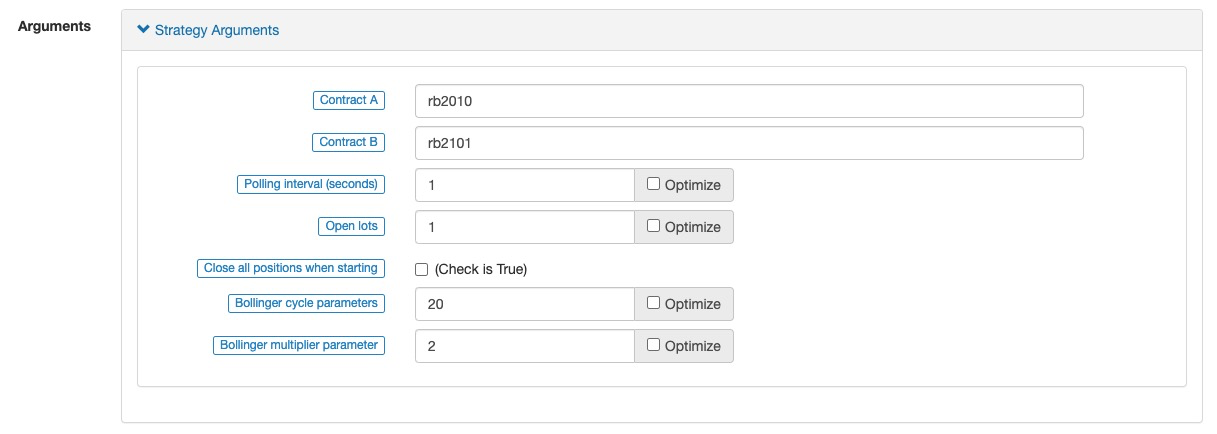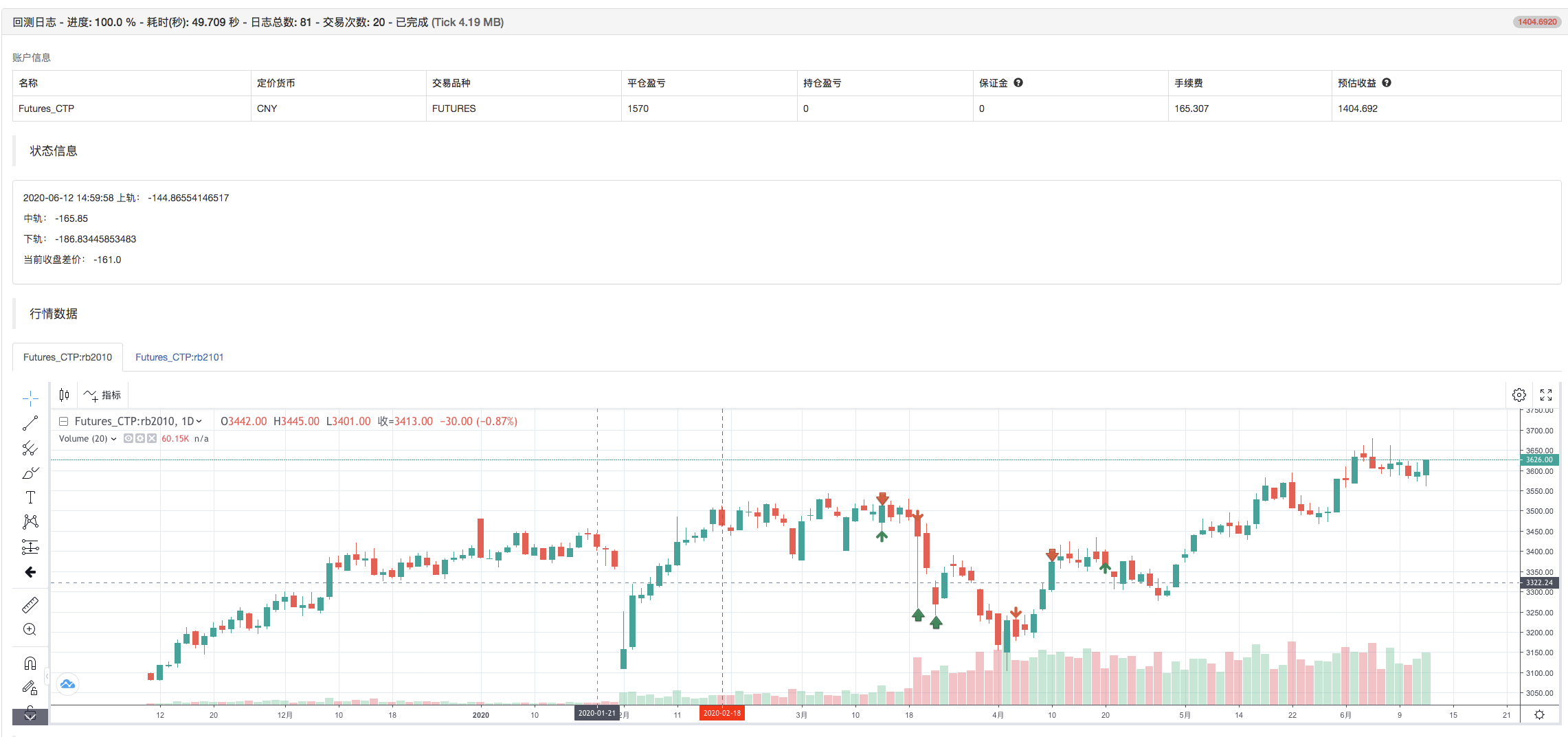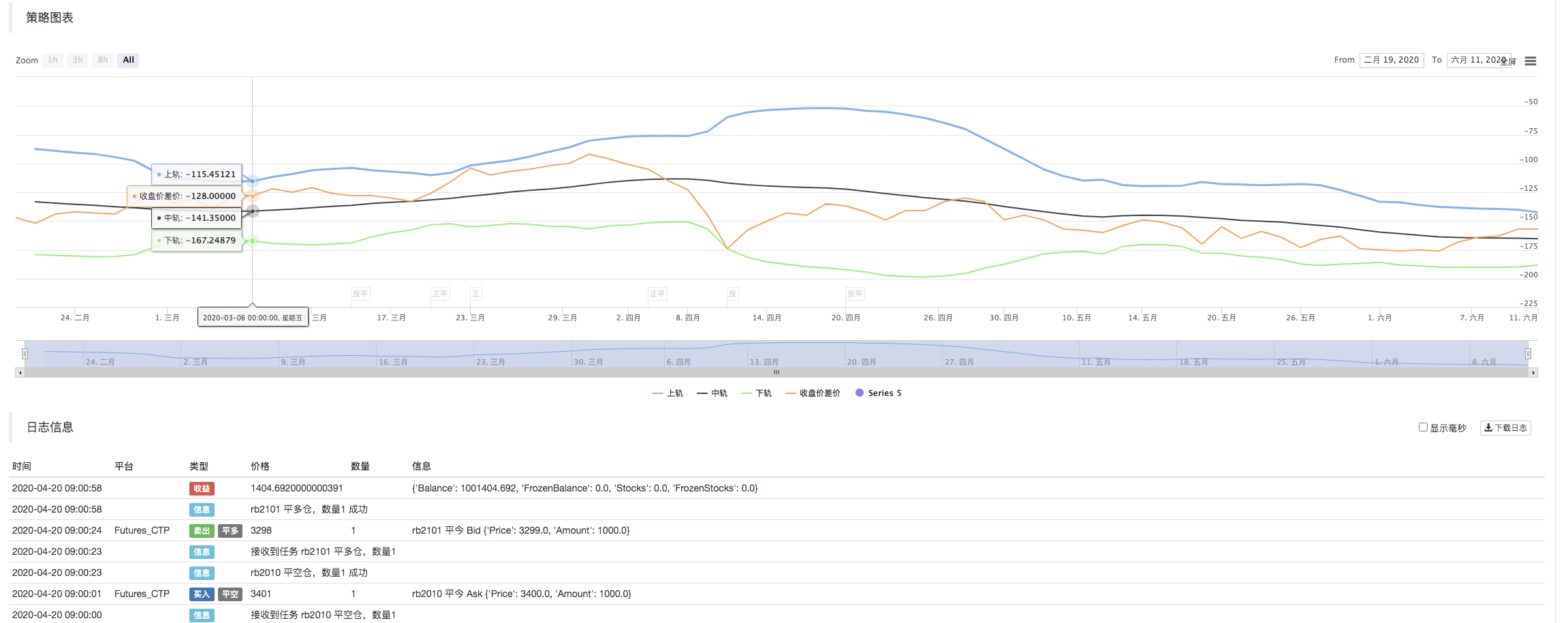Python-Version der Commodity Futures Intertemporal Bollinger Hedge Strategy (nur für Studienzwecke)
Schriftsteller:Gutes, Erstellt: 2020-06-20 10:52:34, Aktualisiert: 2025-01-14 20:40:43
Die zuvor geschriebene intertemporale Arbitrage-Strategie erfordert die manuelle Eingabe des Hedging-Spreads für die Eröffnung und Schließung von Positionen. Das Beurteilen der Preisdifferenz ist subjektiver. In diesem Artikel werden wir die vorherige Hedging-Strategie auf die Strategie der Verwendung des BOLL-Indikators zur Eröffnung und Schließung von Positionen ändern.
class Hedge:
'Hedging control class'
def __init__(self, q, e, initAccount, symbolA, symbolB, maPeriod, atrRatio, opAmount):
self.q = q
self.initAccount = initAccount
self.status = 0
self.symbolA = symbolA
self.symbolB = symbolB
self.e = e
self.isBusy = False
self.maPeriod = maPeriod
self.atrRatio = atrRatio
self.opAmount = opAmount
self.records = []
self.preBarTime = 0
def poll(self):
if (self.isBusy or not exchange.IO("status")) or not ext.IsTrading(self.symbolA):
Sleep(1000)
return
insDetailA = exchange.SetContractType(self.symbolA)
if not insDetailA:
return
recordsA = exchange.GetRecords()
if not recordsA:
return
insDetailB = exchange.SetContractType(self.symbolB)
if not insDetailB:
return
recordsB = exchange.GetRecords()
if not recordsB:
return
# Calculate the spread price K line
if recordsA[-1]["Time"] != recordsB[-1]["Time"]:
return
minL = min(len(recordsA), len(recordsB))
rA = recordsA.copy()
rB = recordsB.copy()
rA.reverse()
rB.reverse()
count = 0
arrDiff = []
for i in range(minL):
arrDiff.append(rB[i]["Close"] - rA[i]["Close"])
arrDiff.reverse()
if len(arrDiff) < self.maPeriod:
return
# Calculate Bollinger Bands indicator
boll = TA.BOLL(arrDiff, self.maPeriod, self.atrRatio)
ext.PlotLine("upper trail", boll[0][-2], recordsA[-2]["Time"])
ext.PlotLine("middle trail", boll[1][-2], recordsA[-2]["Time"])
ext.PlotLine("lower trail", boll[2][-2], recordsA[-2]["Time"])
ext.PlotLine("Closing price spread", arrDiff[-2], recordsA[-2]["Time"])
LogStatus(_D(), "upper trail:", boll[0][-1], "\n", "middle trail:", boll[1][-1], "\n", "lower trail:", boll[2][-1], "\n", "Current closing price spread:", arrDiff[-1])
action = 0
# Signal trigger
if self.status == 0:
if arrDiff[-1] > boll[0][-1]:
Log("Open position A buy B sell", ", A latest price:", recordsA[-1]["Close"], ", B latest price:", recordsB[-1]["Close"], "#FF0000")
action = 2
# Add chart markers
ext.PlotFlag(recordsA[-1]["Time"], "A buy B sell", "Positive")
elif arrDiff[-1] < boll[2][-1]:
Log("Open position A sell B buy", ", A latest price:", recordsA[-1]["Close"], ", B latest price:", recordsB[-1]["Close"], "#FF0000")
action = 1
# Add chart markers
ext.PlotFlag(recordsA[-1]["Time"], "A sell B buy", "Negative")
elif self.status == 1 and arrDiff[-1] > boll[1][-1]:
Log("Close position A buy B sell", ", A latest price:", recordsA[-1]["Close"], ", B latest price:", recordsB[-1]["Close"], "#FF0000")
action = 2
# Add chart markers
ext.PlotFlag(recordsA[-1]["Time"], "A buy B sell", "Close Negative")
elif self.status == 2 and arrDiff[-1] < boll[1][-1]:
Log("Close position A sell B buy", ", A latest price:", recordsA[-1]["Close"], ", B latest price:", recordsB[-1]["Close"], "#FF0000")
action = 1
# Add chart markers
ext.PlotFlag(recordsA[-1]["Time"], "A sell B buy", "Close Positive")
# Execute specific instructions
if action == 0:
return
self.isBusy = True
tasks = []
if action == 1:
tasks.append([self.symbolA, "sell" if self.status == 0 else "closebuy"])
tasks.append([self.symbolB, "buy" if self.status == 0 else "closesell"])
elif action == 2:
tasks.append([self.symbolA, "buy" if self.status == 0 else "closesell"])
tasks.append([self.symbolB, "sell" if self.status == 0 else "closebuy"])
def callBack(task, ret):
def callBack(task, ret):
self.isBusy = False
if task["action"] == "sell":
self.status = 2
elif task["action"] == "buy":
self.status = 1
else:
self.status = 0
account = _C(exchange.GetAccount)
LogProfit(account["Balance"] - self.initAccount["Balance"], account)
self.q.pushTask(self.e, tasks[1][0], tasks[1][1], self.opAmount, callBack)
self.q.pushTask(self.e, tasks[0][0], tasks[0][1], self.opAmount, callBack)
def main():
SetErrorFilter("ready|login|timeout")
Log("Connecting to the trading server...")
while not exchange.IO("status"):
Sleep(1000)
Log("Successfully connected to the trading server")
initAccount = _C(exchange.GetAccount)
Log(initAccount)
def callBack(task, ret):
Log(task["desc"], "success" if ret else "failure")
q = ext.NewTaskQueue(callBack)
p = ext.NewPositionManager()
if CoverAll:
Log("Start closing all remaining positions...")
p.CoverAll()
Log("Operation complete")
t = Hedge(q, exchange, initAccount, SA, SB, MAPeriod, ATRRatio, OpAmount)
while True:
q.poll()
t.poll()
Einstellung der Strategieparameter:

Der Gesamtrahmen der Strategie ist im Wesentlichen derselbe wie derPython-Version der intertemporalen Absicherungsstrategie für Rohstofffutures, mit der Ausnahme, dass die entsprechenden BOLL-Indikatorparameter hinzugefügt werden. Wenn die Strategie ausgeführt wird, werden die K-Liniendaten der beiden Kontrakte erhalten, und dann wird die Preisdifferenz berechnet, um den Spread zu berechnen.TA.BOLLWenn der Spread die oberen Bollinger Bands überschreitet, wird er abgesichert, und wenn er die unteren Bollinger Bands berührt, wird er gegenwärtig betrieben.
Rücktest:



Dieser Artikel ist hauptsächlich nur zu Studienzwecken bestimmt. Vollständige Strategie:https://www.fmz.com/strategy/213826
- Quantitative Praxis der DEX-Börsen (2) -- Benutzerhandbuch für Hyperflüssigkeiten
- DEX-Börsen Quantitative Praxis ((2) -- Hyperliquid Benutzerhandbuch
- Quantitative Praxis der DEX-Börsen (1) -- dYdX v4 Benutzerhandbuch
- Einführung in Lead-Lag-Arbitrage in Kryptowährungen (3)
- DEX-Börsen Quantitative Praxis ((1)-- dYdX v4 Benutzerhandbuch
- Einführung der Lead-Lag-Suite in der Kryptowährung (3)
- Einführung in Lead-Lag-Arbitrage in Kryptowährungen (2)
- Einführung der Lead-Lag-Suite in der digitalen Währung (2)
- Diskussion über den externen Signalempfang der FMZ-Plattform: Eine Komplettlösung für den Empfang von Signalen mit integriertem Http-Service in der Strategie
- FMZ-Plattform: Erforschung von Signalempfangsstrategien für externe Netzwerke
- Einführung in Lead-Lag-Arbitrage in Kryptowährungen (1)
- Der Handel auf der FMEX ermöglicht eine optimale Optimierung des Auftragsvolumens
- Analyse und Realisierung von Rohstofffutures Volumen-Fußabdruck-Diagramm
- FMEX-Sortierung freischaltet Optimum unter Optimierung
- Die Anrufung der Schrauben-Schnittstelle ermöglicht die Botsendung
- FMEX-Transaktionen optimieren die Bestmenge
- Einfache Volatilitäts-EMV-Strategie
- Handschrift zeigt Ihnen, wie Sie eine Python-Politik kostengünstig verpacken können
- Abweichungsrate BIAS-Handelsstrategie
- Bewertung der Kapitalkurve für Backtest mit Hilfe des Werkzeugs "Pyfolio"
- FMZ Quantitative My-Sprache - Schnittstellen
- Schnittstelle mit dem FMZ-Roboter mit dem Indikator "Tradingview"
- FMZ Quantified My Language (Mein) - Parameter für die Handelsbibliothek für My Language
- Anhand der FMZ-Fundamentaldaten ermittelte Kommoditäts-Futures und Spot-Arbitrage-Diagramm
- Hochfrequenz-Backtest-System basierend auf jeder Transaktion und den Mängeln des K-Line-Backtests
- Python-Version der intertemporalen Absicherungsstrategie für Rohstofffutures
- Einige Gedanken zur Logik des Crypto-Währungs-Futures-Handels
- Erweitertes Analyse-Tool basierend auf der Alpha101-Grammatikentwicklung
- Ich zeige Ihnen, wie Sie den Market Collector aktualisieren und die benutzerdefinierte Datenquelle testen.
- Schwachstellen von Hochfrequenz-Rückmeldungssystemen und K-Linien-Rückmeldung auf Basis von Transaktionen pro Stück
- Beschreibung des Mechanismus für die Rückprüfung der FMZ-Simulationsstufe